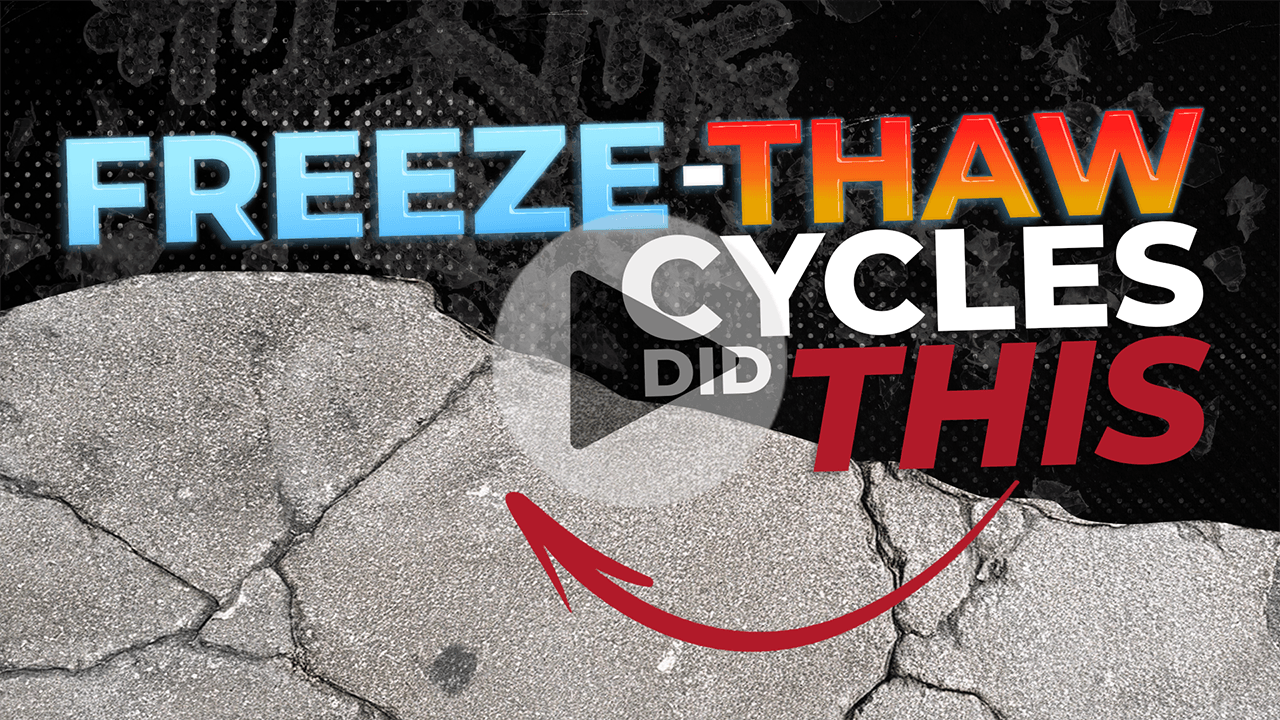Topics:
Search for topics or resources
Enter your search below and hit enter or click the search icon.
Providing your email address will keep you updated should we need to provide updates specific to your location.
December 3rd, 2024 | 3 min. read
By Sarah Etler

While you’re sipping hot cocoa and watching the snow fall, your concrete is expanding and contracting, potentially paving the way for cracks, spalling, and settling from relentless freeze-thaw cycles.
Without proper care, these changes could turn your concrete surfaces into a winter wonderland of damage.
This guide is here to help you stay a step ahead. Before winter's freeze-thaw cycles settle in (and before you finish your hot cocoa), here’s what you need to know about how they damage concrete.
When temperatures drop below freezing, any water absorbed by the concrete freezes and expands. Because concrete is porous, like a sponge, its pores can “pop” when the water within them freezes and expands.
When temperatures rise again, that water thaws, leaving larger empty pockets within the concrete where the pores have popped. As a result, more water can now enter these pores.
This repeated cycle puts stress on concrete, causing internal damage that can lead to cracking, flaking, and settling. These cycles add up, gradually breaking down concrete from within and weakening it over time.
Freeze-thaw cycles don’t just affect the concrete slab itself—they can also disrupt the soil or sub-material below, causing your concrete to shift and settle as it loses the solid support beneath it.
Concrete that faces winter’s worst without protection can develop several types of damage:
Freezing water that expands within concrete pores forces small cracks to form, and over time, these cracks widen and spread.
The surface of the concrete may begin to flake or peel as freeze-thaw cycles create small fractures.
Aggregates within the concrete can break free from the surface, leaving holes and rough patches.
Soil movement below the concrete leads to settling and sinking, creating uneven and potentially dangerous surfaces.
To help your concrete brave the winter, follow these essential survival tips. By keeping moisture out and protecting your concrete’s surface, you’ll help ensure it comes through the winter season unscathed.
Just as you wouldn’t go outside without a coat, your concrete needs a layer of protection to repel water and ice.
Applying a high-quality penetrating sealer creates a barrier against water, preventing it from absorbing into the concrete. If water can’t seep in, it can’t freeze inside your concrete, which causes damage as it freezes and expands.
Pro Tip: If your concrete has already faced some freeze-thaw damage, a sealer can help reduce further wear and tear. Plan to apply it before the freezing temperatures hit for the best results.
Freeze-thaw cycles exploit any weakness they find, and cracks are prime targets. By caulking cracks and joints in your concrete, you prevent water from entering and expanding inside the cracks, or seeping down to the soil beneath.
This step also keeps the material below the slab from expanding and contracting as much, which can help prevent uneven settling. Think of this as sealing up the drafts under your doors—it keeps the cold (or in this case, moisture) out.
Winter means lots of moisture from snowfall and rain. If your gutters are overflowing or downspouts direct water toward concrete surfaces, it can increase the moisture available to freeze inside and under your slabs.
Prevent this by rerouting downspouts and ensuring gutters aren’t leaking, especially near driveways, patios, and sidewalks.
Shoveling might not be your favorite wintertime activity, but keeping concrete surfaces clear of snow helps reduce the moisture your concrete absorbs.
Since the main goal is to minimize freeze-thaw effects, clear the snow as soon as possible after it’s fallen and keep your concrete as dry as possible throughout the season. Every shovel-full you remove means less water freezing and thawing within the concrete.
Voids or empty pockets in the material under a concrete slab are like loose threads on a holiday sweater—they’re small but can unravel the whole structure if ignored.
Concrete leveling fills these gaps, reinforcing your concrete’s foundation. This way, even if freeze-thaw cycles cause minor shifting below, the slab above remains supported, preventing major settling and sinking over time.
As Jack Frost does his thing this winter, remember that freeze-thaw cycles are like an endless tug-of-war between expansion and contraction, stressing concrete until it finally cracks under pressure.
By caulking cracks, redirecting moisture, and giving your concrete a “winter coat,” you can stop these cycles from turning your driveway into the season’s latest concrete statistic.
If you prefer to enjoy that hot cocoa while it’s still warm and the cold’s biting a bit too hard, A-1 Concrete Leveling is here to bring your surfaces back to life. If you’d like expert assistance with cleaning, sealing, caulking, or leveling, request a free onsite cost estimate.
Sarah Etler joined A-1 Concrete Leveling after receiving her Bachelor of Arts degree in English from Northern Kentucky University. As A-1's Content Marketing Manager, she works closely with industry experts to produce content that will best answer questions related to concrete repair and maintenance practices. Sarah loves living a life full of discovery and is excited every day to see what new things she can learn and share with those around her.
Topics: